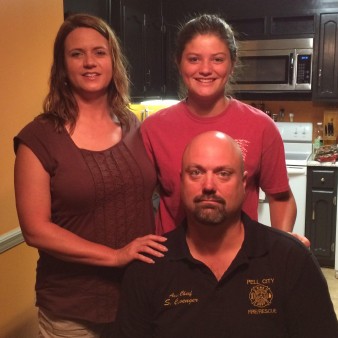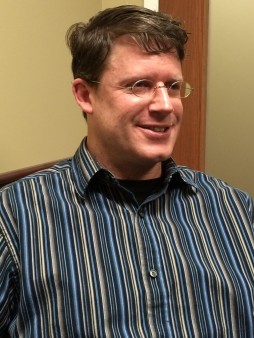New Technology Aims To Measure Concussion Risk In Athletes
Concussions can occur from head injuries while playing any sport where a player receives a blow to the head. And for years, hearing the crack of two helmets colliding or seeing a player crash to the ground headfirst, was the only way to determine if a player might have suffered a concussion. But that’s changing. In the second installment in our series on sports concussions, Les Lovoy reports on a Birmingham company that’s on the forefront of creating sensor technology that allows coaches and physicians to measure the impact to the head — in real time.
Shauna Clevenger (right), was taking batting practice before a softball game and got hit in the head, from a wlld pitch. Her parents, Shannon and Shaun Clevenger took her to a doctor the next morning, who confirmed she had received a concussion.
On a hot summer Saturday afternoon, Shauna Clevenger steps up two the batters box. Her softball team, the “Cobras” is playing in a tournament, outside of Cullman. Shauna’s a, soft-spoken incoming high school freshman, and today she has her long brown hair in pigtails.
A few weeks back, Shauna was taking batting practice before a game. Her coach threw through a wild pitch.
She points to her temple. Shauna, wasn’t wearing a helmet. After the game, she told her mother what happened. For a short time, she felt like she couldn’t speak, and had a headache. Her parents were concerned. Shannon Clevenger is Shauna’s mom.
“And, that night, she came in and had gotten a shower and came in and said when she looked at her phone, it made her head hurt worse,” she said. “So, at the point, we were concerned she possibly had a concussion.”
Her parents took her to a doctor the next morning, who confirmed she had a concussion. Robert Canatu, professor of neurology at Boston University, says they did the right thing. He says getting a concussion, especially while playing football, is similar to a bowl of Jell-O being shaken hard.
“The skull is taking the hit and then the head is being moved and he contents of the head are being very violently shaken. And, they’re being rotated, as well, Canatu explained. “And, those are the factors that stretch the brain tissue, tear brain tissue, windup causing concussions and sometimes worse, such as bleeds within the brain.”
Diagnosing them quickly is key. A number of companies are creating products to help coaches and doctors see if a player possibly has a concussion. These range from special helmets to mouthpieces and caps to headbands. In Alabama, a Birmingham-based company named Archetype recently developed the Player MD system. Jason Cooner is Archetype’s CEO.
“Player MD is basically a sensor-based application,” he said. “We put sensors on skull caps or headbands, monitor impacts on athletes as they’re playing sport and basically what it does is it quantifies the impact into an overall risk assessment.”
Jason Cooner is the CEO of Archetype, a Birmingham-based company, which has created a sensor-based system which measures blows to the heads of athletes.
With data from Player MD’s sensors, Cooner and his team compare a player’s hits to their database of about 2 million impacts. I wanted to see how this technology works first-hand. So, I’m putting on a helmet that a division one football team would wear out on the field. OK Jason, give me a pop.
He shows me a graph that’s appeared on his computer screen.
“If you notice, you have had a very big whack there and have a 25 percent chance of potential concussion in the hospital,” Cooner said. “Now when they get over 10 percent, I say that’s when you need to keep an eye on the kid.”
Dr. Jeffrey Dugas is a surgeon in Birmingham who specializes in sports medicine at Andrews Sport Medicine Orthopedic Center. He’s also team physician for several area high school football teams. Dr Dugas says technology like Archetype’s Player Md can’t diagnose concussions. That’s a call for physicians to make. What it can do is give the medical staff a heads up.
“So, if we know that a kid hits a red line, so to speak, or a threshold at which we’re concerned about a head injury, that doesn’t mean they have a concussion,” Dugas noted. “It doesn’t mean they have a traumatic brain injury. It just means we need to be more aware of it, as the medical professionals, that are on the sidelines, looking at these kids. It raises a red flag with us, and we say we need to make sure that one is ok.”
But coaching staffs are slow to embrace the new technology. One reason is cost. At $150 per, some high schools may find the cost prohibitive. And, there’s the perception among players that someone is “less tough” if they agree to wear something that measure hits. Shaun Clevenger was shaken by his daughter Shauna’s brush with a concussion. He says it’s worth the cost, finically and beyond, to protect young athletes’ heads.
“Anything they can do to help research, I think they should go ahead and participate, especially something we’re so gray in,” Clevenger said.
The “grey” Clevenger is referring to, are the “unknowns” when it comes to diagnosing a concussion. It might take a major shift in culture and attitudes of players and coaches for this technology to become mandatory or standard. For now, some prominent Alabama college football programs are leading the charge. Auburn University uses Player MD during practice and will start equipping players with the sensors during games in the upcoming season. For WBHM, I’m Les Lovoy.
Florida’s 6-week abortion ban will have a ‘snowball effect’ on residents across the South
Abortion rights advocates say the ban will likely force many to travel farther for abortion care and endure pregnancy and childbirth against their will.
Attitudes among Alabama lawmakers softening on Medicaid expansion
Alabama is one of ten states which has not expanded Medicaid. Republican leaders have pushed back against the idea for years.
Birmingham is 3rd worst in the Southeast for ozone pollution, new report says
The American Lung Association's "State of the Air" report shows some metro areas in the Gulf States continue to have poor air quality.
Why haven’t Kansas and Alabama — among other holdouts — expanded access to Medicaid?
Only 10 states have not joined the federal program that expands Medicaid to people who are still in the "coverage gap" for health care
Once praised, settlement to help sickened BP oil spill workers leaves most with nearly nothing
Thousands of ordinary people who helped clean up after the 2010 BP oil spill in the Gulf of Mexico say they got sick. A court settlement was supposed to help compensate them, but it hasn’t turned out as expected.
Q&A: How harm reduction can help mitigate the opioid crisis
Maia Szalavitz discusses harm reduction's effectiveness against drug addiction, how punitive policies can hurt people who need pain medication and more.









